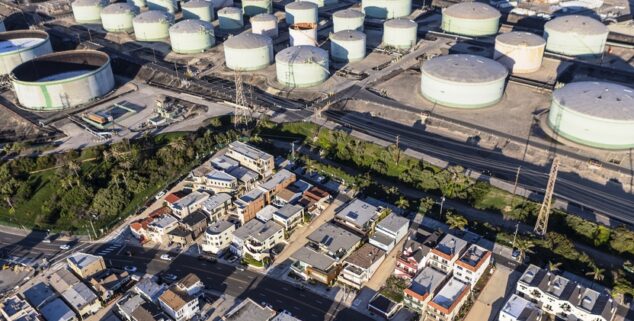Opinion
Those living near gas plants want a healthier future, too
 Homes in a middle-class neighborhood across the street from an oil refinery in Southern California. (Photo: trekandshoot, via Shutterstock)
Homes in a middle-class neighborhood across the street from an oil refinery in Southern California. (Photo: trekandshoot, via Shutterstock)In September, Oxnard residents were startled overnight by what sounded like a series of explosions at the nearby Ormond Beach gas plant. More than 100 Oxnard residents called the police, who told them to contact the Public Utilities Commission.
“I woke up at 3 a.m. thinking it was the end of the world due to the noise. It was disheartening to learn these sounds were coming from the Ormond power plant- yet another scary situation disadvantaged communities were forced to accept,” recalls Oxnard resident Odette Moran, who serves as an organizer with the Central Coast Alliance United for a Sustainable Economy (CAUSE).
Beyond safety risks and intense air pollution impacts, gas plants have also repeatedly been unreliable in moments of high electricity demand
Odette and their neighbors continue to be left in the dark about what happened.
Communities living next to gas plants constantly worry about the next disaster, like the 2021 Russell City Energy Center explosion, that could upend their lives.
Beyond safety risks and intense air pollution impacts, gas plants have also repeatedly been unreliable in moments of high electricity demand. During the hottest week of the year, unanticipated failures at gas power plants accounted for more than one-quarter of the unavailable power. As California grapples with more extreme heat events, gas-fired power plants keep failing to generate the electricity we need.
As a result, community organizer Lizbeth Gonzalez Ruiz lost power on two separate days this summer when temperatures climbed above 100 degrees. Her family’s Los Angeles County home became unbearably hot within minutes, and they took shelter with family nearby as they waited for power to be restored. The first power outage exceeded 10 hours, and she says SoCal Edison’s outage notifications were delayed and mostly inaccurate.
Experiencing a blackout during a heat wave is not just bothersome; it affects our quality of life.
A 2021 California study showed that the lower a neighborhood’s income, the higher the hospitalization rates are on days when heat waves coincide with high pollution. It’s all a vicious cycle, as gas plant emissions fuel more extreme weather. Working-class families and people living with disabilities and chronic health conditions are especially vulnerable during heat waves. They cannot afford the medical bills, food waste, and other costs that come with prolonged power outages.
We must end our state’s toxic relationship with these polluting industries once and for all.
Disadvantaged communities suffer first and worst from air pollution and extreme heat, both of which are linked to burning “natural” gas and other fossil fuels. According to a Physicians Scientist & Engineers (PSE) analysis, around half of California’s gas power plants are located in communities that rank among the top 25 percent most disadvantaged.
In contrast, only nine percent of California power plants are located in the top 25 percent most privileged communities. Eighty-four percent of California’s peaker power plants, which have some of the worst pollution when used, are situated in communities among the 50 percent most disadvantaged. Peaker plants do not necessarily serve the communities they pollute, adding insult to injury for those who bear the burden but may not benefit.
We must end our state’s toxic relationship with these polluting industries once and for all. It’s time for California to phase out gas plants and make room for clean, renewable energy and real climate change solutions. Otherwise, gas plants will continue fostering energy insecurity–and keep undermining California’s climate leadership.
CAUSE is a part of Regenerate California, a coalition working to retire toxic gas plants in working-class communities of color. This month, as a part of its Scoping Plan process, the California Air Resources Board set an interim target of no more than 30 million metric tons of climate emissions from the power sector by 2035. The Scoping Plan is the state’s pollution reduction roadmap that is now being finalized.
Regenerate California is calling on CARB to require gas plants to actually slash the carbon pollution they emit rather than relying on unproven “carbon capture” schemes. Gas plants should be replaced with facilities generating clean, reliable energy, like solar power and battery storage.
There’s nothing more frightening than waking up to a loud bang in the middle of the night. We need to respond to extreme weather, and energy shortfalls, by building an electric grid that is clean, distributed, and renewable. California must get ahead of the next energy crisis by charting a future that does not include toxic, faulty, fickle gas plants.
—
Editor’s Note: Sofia Magallon is a Policy Advocate with the Central Coast Alliance United for a Sustainable Economy (CAUSE) and lives in Oxnard.
Want to see more stories like this? Sign up for The Roundup, the free daily newsletter about California politics from the editors of Capitol Weekly. Stay up to date on the news you need to know.
Sign up below, then look for a confirmation email in your inbox.

Leave a Reply